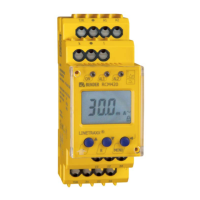Function
11
TGH1410en/03.2012
While the test button T is pressed and held down, all device-related display
elements appear on the display.
3.2.6 Functional faults
If an internal functional fault occurs, all three LEDs flash. An error code will
appear on the display (E01...E32). In such a case please contact the Bender
Service.
3.2.7 Set the number of reload cycles
If faults occur only temporarily, but recurrently, in the system being moni-
tored, with the fault memory M deactivated, the alarm relays would switch
synchronously to the error status.
RL in the out menu can be used to limit the number of these changeover
processes. As soon as the preset number of switching cycles is exceeded, the
fault memory will come on and an activated alarm remains stored.
3.2.8 Assigning alarm categories to alarm relays K1/K2
The alarm categories device error, residual current I
Δn1
, residual current I
Δn2
or
device test can be assigned to the alarm relay via the "out" menu.
3.2.9 Time delays t, t
on
and t
off
The times t, t
on
and t
off,
described below, delay the output of alarms via LEDs
and relays.
3.2.10 Starting delay t
After connection to the supply voltage U
S
, the alarm indication is delayed by
the preset time t (0...10 s).
3.2.11 Response delay t
on1/2
If the response value is exceeded or not reached, the residual current monitor
requires the response time t
an
. After the expiry of the response time an alarm
is signalled. A set response delay t
on1/2
(0...10 s) adds up to the device-related
operating time t
ae
and delays alarm signalling (total delay time t
an
= t
ae
+ t
on
).
If the residual current fault changes from a value above the response value to
a value below the response value, an alarm will not be signalled.

